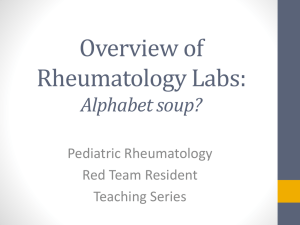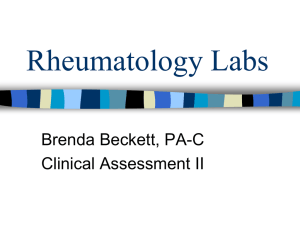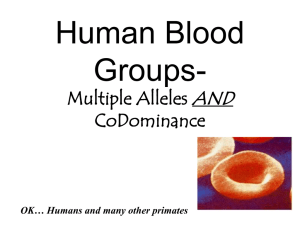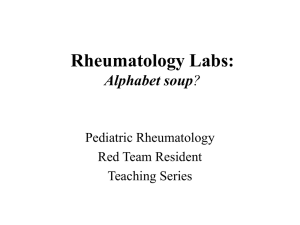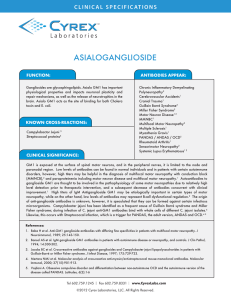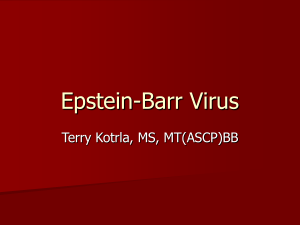antibody.
advertisement
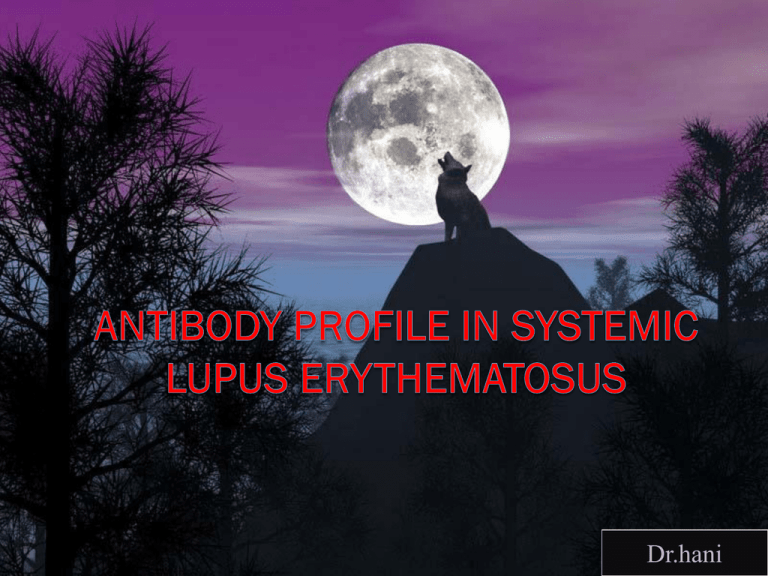
Dr.hani rheumatic diseases rheumatic diseases are characterized by the presence of one or more autoantibodies that may be directe against components of the surface, cytoplasm, nuclear envelope, or nucleus of the cell. Immunofluorescence microscopy using human cellular extracts, such as HEp-2 cells, allows for the sensitive detection of serum antibodies that react very specifically with various cellular proteins and nucleic acids. Systemic Rheumatic Diseases and Related Disorders 1.Systemic lupus erythematosus (SLE) 2. Discoid lupus erythematosus (DLE) 3. Lupus-like syndromes 4. Drug-induced lupus erythematosus 5. Sjogren's syndrome 6. Scleroderma/CREST syndrome (calcinosis cutis, Raynaud's phenomenon, esophageal dysmotility, sclerodactyly, and telangiectasia) 7. Rheumatoid arthritis (RA) 8. Dermatomyositis and polymyositis 9. Overlap syndromes 10. Systemic vasculitis a. Mixed Connective Tissue Disease (MCTD) b. RAand SLE(Rupus) c. SLEand scleroderma (Lupoderma) d. Scleroderma and dermatomyositis (Sclerodermatomyositis) e. Other a. Takayasu's arteritis b. Giant cell arteritis and polymyalgia rheumatica c. Wegener's granulomatosis d. Polyarteritis nodosa and Churg-Strauss syndrome e. Leukocytoclastic vasculitis f. Other 11. Poorly defined connective tissue disease syndromes SLE more than 110different types of autoantibodies have been identified in SLE Widely used tests for screening of intracellular autoantibodies are immunofluorescence microscopy and the immunoenzyme tests.The secondary definitive tests for specific identification of autoantibodies to nuclear antigens are immunodiffusion, immunoprecipitation, particle agglutination, enzyme-linked immunosorbent assay(ELISA), and immunoblolling methods. SLE SLE is characterized by a heterogeneous and polyclonal antibody response, and the usual case of SLE has an average of three different circulating antibodies present simultaneously, including antibody to native DNA (dsDNA), chromatin. Sm antigen, U I nRNP, SS-A/RO, SS-B/La, and several other nonhistone protein or nonhistone protein-RNA complexes . SLE specific for SLE: Anti-native-DNA (up to 90% of patients) anti-Sm anti-ribosomal-RNP and antibody to proliferating cell nuclear antigen (anti-PCNA) Polyclonality of antibodies is seen in SLE and scleroderma, and is rarely seen in the other systemic rheumatic diseases. Autoantibodies in SLE Antibodies to cell nucleus component ANA, anti-dsDNA, antibodies to extracellular nuclear antigen (ENA, anti-Sm, anti-RNP, anti-Jo1) Antibodies to cytoplasmic antigens anti-SSA, ANCA Cell-specific autoantibodies lymphocytotoxic antibodies, anti-neurone antibodies, anti-erythrocyte antibodies, anti-platelet antibodies Antibodies to serum components antiphospholipid antibody anticoagulants antiglobulin, rheumatoid factor Anti-nuclear antibodies(ANA) Antinuclear antibodies (ANAs, also known as antinuclear factor or ANF) are autoantibodies that bind to contents of the cell nucleus. There are many subtypes of ANAs such as: anti-Ro antibodies anti-La antibodies anti-Sm antibodies anti-nRNP antibodies anti-Scl-70 antibodies anti-dsDNA antibodies anti-histone antibodies Antibodies to nuclear pore complex anti-centromere antibodies anti-sp100 antibodies Each of these antibody subtypes binds to different proteins or protein complexes within the nucleus. They are found in many disorders including autoimmunity, cancer and infection, with different prevalences of antibodies depending on the condition. This allows the use of ANAs in the diagnosis of some autoimmune disorders, including systemic lupus erythematosus, Sjögren's syndrome, scleroderma mixed connective tissue disease polymyositis, dermatomyositis, autoimmune hepatitis and drug induced lupus. Serologic hallmarks of patients with systemic autoimmune disease: • SLE – sensitivity, 99 percent • Scleroderma – 97 percent • Mixed connective tissue disease – 93 percent • Polymyositis/dermatomyositis – 61 percent • Rheumatoid arthritis – 52 percent • Rheumatoid vasculitis – 33 percent • Sjögren's syndrome – 90 percent • Drug-induced lupus –100 percent • Discoid lupus – 15 percent • Pauciarticular juvenile chronic arthritis – 71 percent In Chronic infectious diseases (Mononucleosis, Subacute bacterial endocarditis Tuberculosis ) and Other disorders (Some lymphoproliferative diseases) and up to 50 percent of patients taking certain drugs and can also be found in otherwise normal individuals. Anti-nuclear antibodies(ANA) The common tests used for detecting and quantifying ANAs are indirect immunofluorescence and enzyme-linked immunosorbent assay (ELISA). In immunofluorescence, the level of autoantibodies is reported as a titre There are many nuclear staining patterns seen on HEp-2 cells(Human epidermoid cancer cells ): Homogeneous speckled Nucleolar nuclear membranous Centromeric nuclear dot pleomorphic. ANA Screen 8 ELISA (IBL) dsDNA ………………………………plasmid……………………………………………SLE RNP (proteins A, C, 68kDa) ……..human, recombinant ……….MCTD, SLE, RA, PSS Sm (proteins B, B', D) ……………..bovine thymus …………………………………..SLE SS-A/Ro (60kDa-proteAin)………..bovine thymus ……………………………..SS, SLE SS-B/La human,…………………….recombinant ……………………………….SS, SLE Scl-70 (DNA-topoisomerase I)……human, recombinant …………………………..PSS CENP-B human,…………………….recombinant …………………………PSS (CREST) Jo-1 (Histidyl-tRNA-synthetase) ….human, recombinant…………………………… PM disadvantages of the ELISA compared to IFA include a lack of sensitivity to unknown nuclear and cytoplasmic antigens the lack of an ANA pattern that has historically been reported with the IFA the diagnostic utility of an ANA of unknown specificity is not clear at this time since many healthy people are ANA positive but negative for diagnostically important autoantibodies once a specific reactivity is identified in the serum, the ANA pattern is no longer as important for diagnosis. Thus, the ANA ELISA clearly has a useful place in a clinical laboratory. Nucleolar proteins Nucleolar Ro La dsDNA Smith Rim RNP Jo-1 Speckled Scl-70 Ro Homogenous Nucleosomes homogeneous pattern is seen when the condensed chromosomes and interphase chromatin stain. This pattern is associated with anti-dsDNA antibodies, antibodies to nucleosomal components, and anti-histone antibodies. There are two speckled patterns: fine and coarse. The fine speckled pattern has fine nuclear staining with unstained metaphase chromatin, which is associated with anti-Ro and anti-La antibodies. The coarse staining pattern has coarse granular nuclear staining, caused by anti-U1-RNP and anti-Sm antibodies. The nucleolar staining pattern is associated with many antibodies including anti-Scl70, anti-PM-Scl, anti-fibrillarin and anti-Th/To. Nuclear membrane staining appears as a fluorescent ring around the cell nucleus and are produced by anti-gp210 and anti-p62 antibodies. The centromere pattern shows multiple nuclear dots in interphase and mitotic cells, corresponding to the number of chromosomes in the cell. Nuclear dot patterns show between 13–25 nuclear dots in interphase cells and are produced by anti-sp100 antibodies. Pleomorphic pattern is caused by antibodies to the proliferating cell nuclear antigen. Indirect immunofluorescence has been shown to be slightly superior compared to ELISA in detection of ANA from HEp-2 cells Antigen Molecular Structure Autoantibody Frequency (%) Native DNA Double-strand DNA 40-90 Denatured DNA Single-strand DNA 70 Histones Hl,H2A.H2B,H3,H4 50-70 Chromatin(nucleosome) DNA·histones complex 50-90 Sm Proteins 29 (B'), 28 (B). 16 (D).and 13(E) 15-30 kDa, complexed with UI ,U2. and U4·U6 snRNAs; spliceosome component Nuclear RNP (Ul nRNP) Proteins 70, 33(A), and 22 (C) kDa. complexed with Ul snRNA; spliceosome component 30-40 SS-A/Ro Proteins 60 and 52 kDa, Complexed with Yl-Y5 RNAs 24-60 SS-B/La Phosphoproteins 48 kDa, complexed with YI nascenl RNA Pol transcripts 9-35 Antigen Molecular Structure Autoantibody Frequency (%) Ku Proteins 86 and 66 kDa. DNA-binding proteins 1-19 hnRNP protein Al Nuclear protein 34 kDa 31-37 PCNA Protein 36 kDa; auxiliary protein of DNA polymerase 3 Ribosomal RNP Phosphoproteins 38. 16, and IS kDa associated with ribosomes 10-20 Hsp·90 Heat-shock protein 90 kDa 5-50 Golgi complex Golgins, giantin Unknown HMG-17 DNA-associated proteins, 9 to 17 kDa 34-70 B2-glycoprotein I Anionic phospholipids. cardiolipin 25 Antibodies to Native DNA or Double-Stranded DNA specific for SLE 40-90% in SLE in 75-90% of active untreated SLE patients Transient increases in anti-DNA antibodies were recently described in RA patients treated with antiTNF therapy reactive antibodies to DNA in the other diseases are anti-single-stranded-DNA antibodies. antibody to DNA is followed by the appearance of circulating DNA antigen, Such DNA-anti-DNA immune complexes, mostly containing complementactivating IgG3, have a special tropism for basement membranes and are readily deposited in the kidney glomeruli. Hypothetical mechanism for the initiation of lupus nephritis by basement membrane (BM)–binding antidouble-stranded DNA (dsDNA) antibody. The stage I to II transition is likely to be reversible.62 The stage II to III transition associated with the progressive accumulation of antibody and chromatin into immune complexes will eventually reach a threshold for which the immune complex deposition is no longer reversible. This stage would yield chronic inflammation and lupus nephritis Confocal micrographs of kidney cryosections Co-localization of IgG with heparan sulfate proteoglycan (HSPG) is clearly identified as turquoise Antibodies to Native DNA or Double-Stranded DNA Earlier methods for detection of DNA antibodies were the insensitive precipitation method, complement fixation, and passive hemagglutination. Current methods used are radioimmunoassay (RIA). Indirect immunofluorescence (IFA) on Crithidia luci/iae, and enzymelinked immunosorbent assay Negative staining of both kinetoplast and the nucleus. Positive dsDNA :Staining of kinetoplast lying near the base of flagellum. Ethidium bromide (red) added to show the nuclei of crithidia. The problem with ELISAs is that they detect both low and high avidity dsDNA antibody (some ELISAs will also detect single stranded DNA). High avidity anti-dsDNA antibodies are specific for SLE associated nephritis which is successfully detected by crithidia and FARR assay. Antibodies to Sm and Nuclear Ribonucleoprotein(nRNP) The spliceosomes consist primarily of RNA-protein complexes called small nuclear ribonucleoproteins (snRNPs). The snRNPs are composed of small nuclear RNAs (snRNAs) U1, U2, U4, U5 and U6 - as well as a group of seven proteins known as Sm ribonucleoproteins that collectively make up the extremely stable Sm core of the snRNP. Antibodies to Sm and Nuclear Ribonucleoprotein(nRNP) Highly specific Sm and nRNP antigens were clearly associated, because the nRNP could not be biochemically isolated from Sm antigen Sm and nRNP antigens were subcellular particles comprised of small nuclear RNAs complexed with proteins (at leastseven proteins varying in molecular mass from 12 to 68 kDa). found at a frequency of 30-40% in active SLE No characteristic clinical feature,Patients who have antibodies to only nRNP have a low frequency of antibodies to DNA and a low frequency of clinically apparent renal disease Antibodies to Sm and Nuclear Ribonucleoprotein(nRNP) Anti-Sm and anti-nRNP antibodies may be deteaed by immunodiffusion, passive hemagglutination, or counterimmunoelectrophoresis.(do not accurately distinguish between antibodies against different small nuclear-RNA-associated polypeptides) Immunoblotting has been found to be more sensitive than conventional methods for the detection of anti-Sm and anti-nRNP. Currently, the most widely used laboratory tests for the detection of anti-Sm and antinRNP antibodies are immunodiffusion and ELISA.(cannot define these pecific antibody epitopes) Ro/SSA ANTIGENS two cellular proteins with molecular weights of approximately 52 and 60 kD referred to as “Ro52” and “Ro60,” Ro60 localized to the nucleus and nucleolus and with Ro52 localized to the cytoplasm. Ro60 was shown to bind small, non-coding ribonucleic acids (RNAs) termed “Y RNAs.” Although the function of Y RNAs is unknown, one report suggests that Y RNAs may be a source of micro (mi)RNA molecules, which have a role in the regulation of messenger (m)RNA stability and translation the protein can bind to both single- and double-stranded RNA. The protein may function as a “RNA chaperone Ro60 may also bind to other cellular and viral RNAs in the cell, including Epstein-Barr virus (EBV) early RNA 1 (EBER1) Ro52 :The protein localizes to the cytoplasm and functions as an E3 ubiquitin ligase, an enzyme that adds ubiquitin molecules to target proteins [4]. SSB/La ANTIGENS the SSB/La antigen was highly concentrated in the nucleolus of cells during the late G1 and early S phase and is thus cell cycle-related Stimulate the activity of polymerase alpha and beta suggesting a further role in elongation DNA replication(associated with RNA polymerase III transcripts ) Role in DNA excision repair Antibodies to SS-A/Ro and SS-B/La Patients with SLE can have antibodies to SS-A/Ro alone or may have both anti- SS-A/Ro and anti-SS-B/La anti-SS-A/Ro alone is strongly associated with HLA DR2 and with being young «22 years of age at onset). both anti-SS-A/Ro and anti-SS-B/La in SLE is associated with HLA-DR3 and is seen in older patients (>50 years of age at disease onset) patients with anti-SS-A/Ro alone had much more serious renal disease Anti SS-A/Ro autoantibodies have been closely associated with the appearance of nephritis, vasculitis, lymphadenopathy, photosensitivity and leukopenia in SLE patients Anti-SS-B/La antibodies, like anti-SS-A/Ro antibodies, are antibodies noteworthy for their strong association with Sjogren's syndrome. Antibodies to SS-A/Ro and SS-B/La During pregnancy, anti-Ro antibodies can cross the placenta and cause neonatal lupus in babies The 60kDa DNA/RNA binding protein and 52kDa T-cell regulatory protein are the best characterised antigens of anti-Ro antibodies. Collectively, these proteins are part of a ribonucleoprotein (RNP) complex that associate with the hyRNAs, hY1-hY5. The La antigen is a 48kDa transcription termination factor of RNA polymerase III, which associates with the Ro-RNP complex. Antibodies to SS-A/Ro Elevated levels of SS-A/Ro antibodies are related to several clinical autoimmune disorders, including: (I) subacute cutaneous lupus erythematosus, (2) neonatal lupus erythematosus syndrome with congenital heart block and cutaneous lesions, (3) homozygous C2 and C4 deficiency with SLE-Iike disease, (4) primary Sjogren's syndrome vasculitis, rheumatoid factor positivity and severe systemic symptoms, (5) ANA-negative SLE. Pattern: SSB Substrate: Hep2-cells SPECKELED PATTERN SSA Fine fluorescence of nuclei sometimes surrounded by „fluorescent dust“. This pattern is variable dependent on the brand of Hep 2-cells Anti-Ku Ku-antigen system consists of a pair of proteins called p70/p80 DNA-binding proteins, interacting covalently with the ends of native DNA found in 10% of 5LE sera and was not detected in 100 scleroderma in immunoblot assays 39% of SLE, 55% of mixed connective tissue disease (MClD), and 40% of scleroderma patients had low levels of antibody to Ku protein by elisa Anti-Ki first reported in Japan in 1981 In 10% of SLE patients relationship was observed between anti-Ki and the clinical features of arthritis, pericarditis, and pulmonary hypertension in SLE patients In ELlSA anti-Ki antibodies are observed in 21% of SLE patients while 7% were positive for anti-Ki by doubleimmunodiffusion tests. Antibodies to P Ribosomal Proteins Up to-20% of SLE sera show autoantibodies targeting three ribosomal phosphoproteins of 15, 18, and 38 kDa differences in the prevalence of anti-rRNP are found among races. occur in a higher frequency together with anti-sm and anti-U 1nRNP antibodies in SLE Association with major central nervous system disorders in SLE, mainly psychotic symptoms, No association was shown with cognitive impairment or depression Association with hemolytic anemia, leukopenia, alopecia, malar rash, proteinuria, and neurologic complications There was no correlation with disease activity. Proliferating Cell Nuclear Antigen PCNA complex has been characterized as cell-cycle-related in 3% of patients with active SLE show no distinctive clinical associations A possible association with central nervous system features, such as transverse myelitis Antiphospholipid Antibodies found in up to 60% of patients with SLE also in other disorders such as infectious diseases The majority of anticardiolipin antibodies cross-react with zwitterionic (dipolar ion) phospholipids. Antibodies to anionic phospholipids may be IgG or IgM, whereas antibodies to zwitterionic phospholipids are more frequently IgM. Antiphospholipid Antibodies Antibodies to phospholipids are identified in SLE patients in three ways (1) serologically false-positive test for syphilis by a positive Venereal Disease Research Laboratory (VDRL) test, which is a flocculation assay using carbon particles coated with cholesterol, lecithin (phosphatidylcholine), and cardiolipin (2) the lupus anticoagulant assay, which is a prolongation of the kaolin partial thromboplastin time that is not corrected by normal plasma; and (3) cardiolipin immunoassay with the use of cardiolipin or other negatively charged phospholipids as antigens and B2-glycoprotein I as co-factor. standard units (GPL and MPL) for anti phospholipid antibody immunoassays:One GPL (MPL) unit is equivalent to 1 mg/mL of an affinitypurified standard IgG (lgM) sample Antiphospholipid Antibodies Newly developed assays for B2glycoprotein I autoantibodies seem to bring specificity to the findings, since it was described that the B2-glycoprotein is the specific epitope for anti-phospholipid autoantibodies Funhermore, IgAantibodies targeting B2glycoprotein I, or antibodies recognizing a complex of B2-GP I/oxLDL (oxidized low density lipoprotein) seem to be pathogenic in atherosclerotic vascular disease Histone autoantibodies Histones are basic molecular proteins containing high molar ratios of the positively charged amino acids lysine and arginine. The subunit of this histone-DNA complex is called a nucleosome, which has two molecules of each of the 'core' histones (H2A, H2B, H3, and H4) and one molecule of HI, along with DNA of about 200 base pairs in length Acetyltransferase is an enzyme that can acetyl ate drugs such as hydralazine and procainamide, playing an important role in detoxification and excretion of the drug. Patients with low levels of acetyltransferase were more prone to develop ANA and clinical symptoms Histone autoantibodies In drug-induced lupus, antibodies to single-stranded DNA and histones are present. In SLE, on the other hand, antibodies to double-stranded native DNA, Sm, and UlnRNP antigens are often present In the asymptomatic patients, the antihistone antibody is predominantly IgM and displays broad reactivity with all of the individual histones. Patients with symptomatic disease develop a unique type of IgG anti histone antibody, which, rather than reacting with individual histones, shows specific reactivity with the histone H2A-H2B dimer complex Since anti histone antibodies are found in many other conditions, more specific antibodies such as antichromatin are replacing assays for antihistones ANA Testing Guideline #1 Test for autoantibodies only when a consistent clinical suspicion of rheumatic disease is present. Not a good screening test for patients with vague symptoms ANA can be positive in sick people (nonrheumatic) and healthy people ANA Testing Anti-Nuclear Antibodies, but they can also be anti-cytoplasmic Immunofluorescence is commonly used In the past patients serum was placed on to slides with rodent (or other animal) cells and IF was performed to look for antibodies binding to cellular components What problems does this cause? Human and rodent cells differ (slightly), and so some people with obvious rheumatic disease would be negative on this test. “ANA-negative lupus” Now there are human tumor cell lines that are used (HEp-2 are preferred) Another source of false negatives includes how the tissues are fixed onto the slides Ethanol and methanol fixation may remove Ro/SSA antigens from cells, so the cells are fixed with acetone How is the test done? Patient serum is diluted and dropped onto HEp-2 slides (cells fixed into separate dots on the slide) Incubated, washed, secondary antibody added Read by a tech using an IF scope (takes specialized training and there is inherent variability between individuals) Results Results typically include positive/negative, titer and pattern of staining Titers less than 1:40 should be considered negative (20-30% of healthy people) Titers of 1:40 to 1:160 should be considered positive at low titer (further workup is not recommended in the absence of specific symptoms) Results Titers equal to or greater than 1:160 should be considered positive and further workup should be done (only 5% of healthy people). Prevalence of SLE is 40-50 in 100,000 (but 5,000 will have + ANA) Each hospital can change these cutoffs based on their patient population What Follow-up Testing? Ideally this would depend on clinical symptoms, but often: dsDNA Sm nRNP Ro/SSA La/SSB Scl-70 Jo-1 Patterns The IF pattern is still reported, but does not correlate well with what the antibody’s specificity is. It was the most you could do “back in the day” Now with ELISA testing for specific antigens possible, the ANA pattern has a low relevance Patterns Peripheral or rim = dsDNA Homogenous = dsDNA, histones Speckled = many antigens Nucleoli = associated with scleroderma Centromeric = CREST syndrome Cytoplasmic = myositis, mitochondrial This homogenous pattern of diffuse bright green staining of nuclei seen by immunofluorescence microscopy with a Hep2 cell substrate is called homogenous, and is the most common pattern with autoimmune diseases overall. This rim (peripheral ) pattern of linear bright green staining around the peripheral of nuclei seen by immunofluorescence microscopy with a Hep2 cell substrate . dsDNA Nucleolar pattern Speckled pattern SSA, SSB, Sm Sp100_nuclear_antigen Patterns These little Crithidia organisms have a small kinetoplast between the nucleus and the flagella which glows bright green under immunofluorescence microscopy, and is indicative of anti-native DNA antibody that is very specific for SLE. To summarize… You screen for ANAs using IF on slides with HEp-2 cells If it’s positive you look for the specific antigen that the antibody is reacting to using ELISA (the antigen is stuck to the well) or other methods We don’t screen for ANAs using ELISA because it’s hard to get all the various antigens (40+) onto the well walls dsDNA Guidelines suggest checking for antidsDNA antibodies only when the symptoms are suspicious of SLE AND the ANA is positive The “ANA-negative lupus” patients are REALLY rare now that we test with HEp2 cells rather than animal cells Guidelines suggest that the only antibodies that need to be quantified are dsDNA (to predict a flare, and nephritis risk) Active disease (q 6-12 weeks) Less active disease (q 6-12 months) Report quantitative results on isolated U-RNP antibodies (part of criteria for MCTD) Thanks

